
KRS Definition of Bullying: Amend KRS 158.148 to define “bullying”; require a school board’s code of acceptable behavior to prohibit bullying; require the code to include procedures for investigating and responding to reports of bullying and a method to protect a person reporting a bullying incident.
(1) (a) As used in this section, “bullying” means any unwanted verbal, physical, or social behavior among students that involves a real or perceived power imbalance and is repeated or has the potential to be repeated:
1. That occurs on school premises, on school-sponsored transportation, or at a school-sponsored event; or
2. That disrupts the education process.
(b) This definition shall not be interpreted to prohibit civil exchange of opinions or debate or cultural practices protected under the state or federal Constitution where the opinion expressed does not otherwise materially or substantially disrupt the education process.
KRS 525.070 Harassment. (1) A person is guilty of harassment when, with intent to intimidate, harass, annoy, or alarm another person, he or she:
(a) Strikes, shoves, kicks, or otherwise subjects him to physical contact;
(b) Attempts or threatens to strike, shove, kick, or otherwise subject the person to physical contact;
(c) In a public place, makes an offensively coarse utterance, gesture, or display, or addresses abusive language to any person present;
(d) Follows a person in or about a public place or places;
(e) Engages in a course of conduct or repeatedly commits acts which alarm or seriously annoy such other person and which serve no legitimate purpose; or
(f) Being enrolled as a student in a local school district, and while on school premises, on school-sponsored transportation, or at a school-sponsored event;
1. Damages or commits a theft of the property of another student;
2. Substantially disrupts the operation of the school; or
3. Creates a hostile environment by means of any gestures, written communications, oral statements, or physical acts that a reasonable person under the circumstances should know would cause another student to suffer fear of physical harm, intimidation, humiliation, or embarrassment.
(2) (a) Except as provided in paragraph (b) of this subsection, harassment is a violation.
(b) Harassment, as defined in paragraph (a) of subsection (1) of this section, is a Class B misdemeanor.
Effective: July 15, 2008 History: Amended 2008 Ky. Acts ch. 125, sec. 4, effective July 15, 2008. — Amended 1996 Ky. Acts ch. 345, sec. 3, effective July 15, 1996. — Created 1974 Ky. Acts ch. 406, sec. 217, effective January 1, 1975.
KRS 525.080 Harassing communications.
(1) A person is guilty of harassing communications when, with intent to intimidate, harass, annoy, or alarm another person, he or she:
(a) Communicates with a person, anonymously or otherwise, by telephone, telegraph, mail, or any other form of written communication in a manner which causes annoyance or alarm and serves no purpose of legitimate communication;
(b) Makes a telephone call, whether or not conversation ensues, with no purpose of legitimate communication; or
(c) Communicates, while enrolled as a student in a local school district, with or about another school student, anonymously or otherwise, by telephone, the Internet, telegraph, mail, or any other form of electronic or written communication in a manner which a reasonable person under the circumstances should know would cause the other student to suffer fear of physical harm, intimidation, humiliation, or embarrassment and which serves no purpose of legitimate communication.
(2) Harassing communications is a Class B misdemeanor.
Effective: July 15, 2008 History: Amended 2008 Ky. Acts ch. 125, sec. 5, effective July 15, 2008. — Created 1974 Ky. Acts ch. 406, sec. 218, effective January 1, 1975.
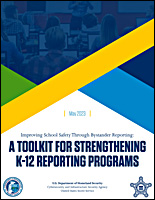 The willingness of bystanders to come forward with concerns for the wellness and safety of themselves or others is a key component of student health and violence prevention efforts in kindergarten through 12th grade (K12) schools. The CISA-USSS K-12 Bystander Reporting Toolkit is designed to help community leaders create tailored, customized approaches to encourage reporting that meet the needs of their unique communities. It can be used to inform safety planning for the range of K-12 schools across the United States and is applicable to diverse geographical contexts ranging from rural to urban, and to schools and districts at various levels of maturity in their approach to reporting.
The willingness of bystanders to come forward with concerns for the wellness and safety of themselves or others is a key component of student health and violence prevention efforts in kindergarten through 12th grade (K12) schools. The CISA-USSS K-12 Bystander Reporting Toolkit is designed to help community leaders create tailored, customized approaches to encourage reporting that meet the needs of their unique communities. It can be used to inform safety planning for the range of K-12 schools across the United States and is applicable to diverse geographical contexts ranging from rural to urban, and to schools and districts at various levels of maturity in their approach to reporting.
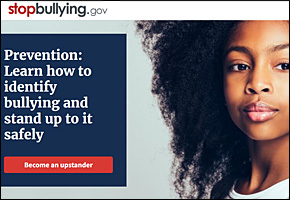 This federal government website is managed by the U.S. Department of Health & Human Services. It includes information on bullying, cyberbullying, prevention of both, and many other useful resources. Parents, school staff, and other adults in the community can help kids prevent bullying by talking about it, building a safe school environment, and creating a community-wide bullying prevention strategy. Some resources include: Why Some Youth Bully; Being Kind Helps Prevent Bullying and Bullying Prevention Training Center
This federal government website is managed by the U.S. Department of Health & Human Services. It includes information on bullying, cyberbullying, prevention of both, and many other useful resources. Parents, school staff, and other adults in the community can help kids prevent bullying by talking about it, building a safe school environment, and creating a community-wide bullying prevention strategy. Some resources include: Why Some Youth Bully; Being Kind Helps Prevent Bullying and Bullying Prevention Training Center
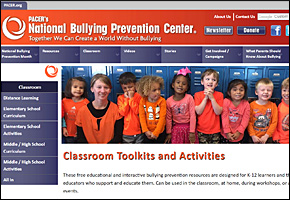 Pacer – Classroom Toolkits – There are activities for younger students, as well as middle and high school. Also, a student created toolkit is listed with videos, music and artwork designed by students for other students to use. This is a great way to create a dialogue with your class. They can be the solution and a superhero as they work together to stop bullying.
Pacer – Classroom Toolkits – There are activities for younger students, as well as middle and high school. Also, a student created toolkit is listed with videos, music and artwork designed by students for other students to use. This is a great way to create a dialogue with your class. They can be the solution and a superhero as they work together to stop bullying.
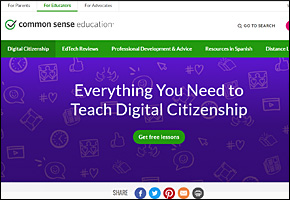 This FREE, pioneering K -12 digital citizenship curriculum is designed to empower students to think critically and make informed choices about how they create, communicate, and treat others in our ever-evolving, 24/7 digital world.
This FREE, pioneering K -12 digital citizenship curriculum is designed to empower students to think critically and make informed choices about how they create, communicate, and treat others in our ever-evolving, 24/7 digital world.
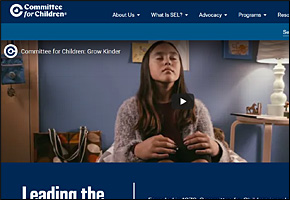 The researched based STEPS TO RESPECT program teaches elementary students to recognize, refuse, and report bullying, be assertive, and build friendships. In fact, a recent study found that the program led to a 31 percent decline in bullying and a 70 percent cut in destructive bystander behavior. This curriculum is one example of an evidence-based curriculum.
The researched based STEPS TO RESPECT program teaches elementary students to recognize, refuse, and report bullying, be assertive, and build friendships. In fact, a recent study found that the program led to a 31 percent decline in bullying and a 70 percent cut in destructive bystander behavior. This curriculum is one example of an evidence-based curriculum.
 Present a unique and comprehensive approach to preventing youth violence by targeting the root causes of bullying and other forms of social cruelty. It exposes the cultural expectations that teach young people to humiliate and dehumanize others as the way to achieve power and respect, then challenges them to transform this dynamic. A CD is included for a nominal fee.
Present a unique and comprehensive approach to preventing youth violence by targeting the root causes of bullying and other forms of social cruelty. It exposes the cultural expectations that teach young people to humiliate and dehumanize others as the way to achieve power and respect, then challenges them to transform this dynamic. A CD is included for a nominal fee.
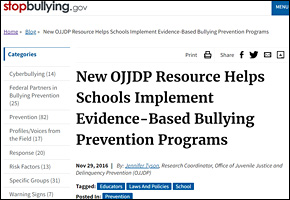 Stopbullying.gov – Schools across the U.S. frequently confront the issue of bullying among their student population. … The newest feature of OJJDP’s Model Programs Guide website, the I-Guide analyzes research and evaluation to identify how bullying prevention programs have been implemented in schools.
Stopbullying.gov – Schools across the U.S. frequently confront the issue of bullying among their student population. … The newest feature of OJJDP’s Model Programs Guide website, the I-Guide analyzes research and evaluation to identify how bullying prevention programs have been implemented in schools.
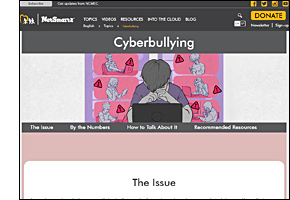 NetSmartz – 20-30% of kids report having been cyberbullied in their lifetime. Resources to help deal with cyberbullying – such as “Cyberbullying Unplugged (PDF)”.
NetSmartz – 20-30% of kids report having been cyberbullied in their lifetime. Resources to help deal with cyberbullying – such as “Cyberbullying Unplugged (PDF)”.
 Elementary Lesson Plan – Spookley the Square Pumpkin by Pacer is a square pumpkin who lives in a round pumpkin patch world. In The Legend of Spookley the Square Pumpkin, a perennial fall favorite children’s story, Spookley helps you understand that the things that make you different are what make you special.
Elementary Lesson Plan – Spookley the Square Pumpkin by Pacer is a square pumpkin who lives in a round pumpkin patch world. In The Legend of Spookley the Square Pumpkin, a perennial fall favorite children’s story, Spookley helps you understand that the things that make you different are what make you special.
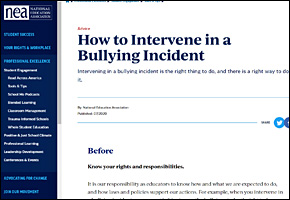 National Education Association – It is our responsibility as educators to know how and what we are expected to do, and how laws and policies support our actions. For example, when you intervene in a bullying incident, you are not infringing on the bullying student’s right to free speech. … Ultimately, the steps to take to intervene should be trained and discussed as a part of a comprehensive school-wide bullying prevention program.
National Education Association – It is our responsibility as educators to know how and what we are expected to do, and how laws and policies support our actions. For example, when you intervene in a bullying incident, you are not infringing on the bullying student’s right to free speech. … Ultimately, the steps to take to intervene should be trained and discussed as a part of a comprehensive school-wide bullying prevention program.
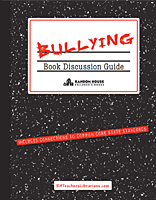 Includes Connections to Common Core State Standards @ RHTeachersLibrarians.com. School Counselor, Laura Barbour has taught and counseled children from preschool through high school and presently works as an elementary professional school counselor at Stafford Primary School in West Linn, Oregon. (Random House Inc)
Includes Connections to Common Core State Standards @ RHTeachersLibrarians.com. School Counselor, Laura Barbour has taught and counseled children from preschool through high school and presently works as an elementary professional school counselor at Stafford Primary School in West Linn, Oregon. (Random House Inc)
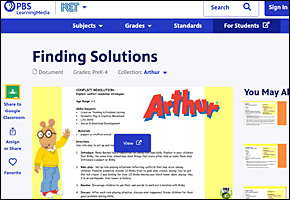 Students in grades 2-5 can use these activities to practice skills in resolving conflicts with bullies and help them think critically about logical resolutions. Teasing is Tough – Get children to talk about how it feels to be teased. Work together to create coping strategies, in this activity from Arthur. (PBS Learning Media)
Students in grades 2-5 can use these activities to practice skills in resolving conflicts with bullies and help them think critically about logical resolutions. Teasing is Tough – Get children to talk about how it feels to be teased. Work together to create coping strategies, in this activity from Arthur. (PBS Learning Media)
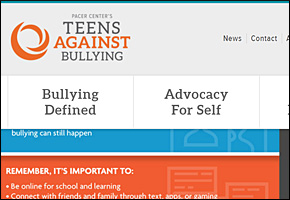 This site for middle and high school students includes interactive sections on defining bullying, feelings about bullying, how to respond to bullying and scenarios/ testimonials from students who have been bullied. Search the website by clicking on the headings across the top of page, “Identify”, “Respond”, “Listen” etc., to access useful and up-to-date information about how to approach and prevent bullying. (PACER’S National Center for Bully Prevention)
This site for middle and high school students includes interactive sections on defining bullying, feelings about bullying, how to respond to bullying and scenarios/ testimonials from students who have been bullied. Search the website by clicking on the headings across the top of page, “Identify”, “Respond”, “Listen” etc., to access useful and up-to-date information about how to approach and prevent bullying. (PACER’S National Center for Bully Prevention)
 This site has many creative resources to educate elementary students about bullying. It includes an animated cast of characters, information, celebrity videos, Webisodes, interactive games, animation, contests, and other activities. (PACER’S National Center for Bully Prevention)
This site has many creative resources to educate elementary students about bullying. It includes an animated cast of characters, information, celebrity videos, Webisodes, interactive games, animation, contests, and other activities. (PACER’S National Center for Bully Prevention)
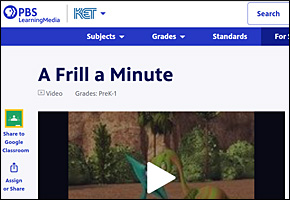 In this Dinosaur Train episode, the Pteranodon kids and Tank Triceratops play games at Big Pond, where they discuss the purpose of Tank’s frill, and outsmart a bully. They learn that Tank’s frill is a defense mechanism which makes the Triceratops look threatening to potential predators. (Stream Only)
In this Dinosaur Train episode, the Pteranodon kids and Tank Triceratops play games at Big Pond, where they discuss the purpose of Tank’s frill, and outsmart a bully. They learn that Tank’s frill is a defense mechanism which makes the Triceratops look threatening to potential predators. (Stream Only)
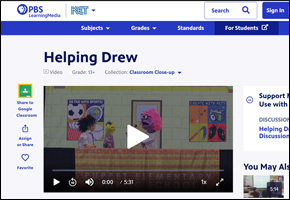 In this episode of NJEA’s Classroom Close-up, pre-K and kindergarten students at Teaneck‘s Bryant Elementary School get an early anti-bullying lesson from a teacher-produced puppet show called “Helping Drew”. Elementary school educator, Alex Ishkanian, combines his passion for the performing arts and his education background to create engaging, dramatic programs for elementary-school-aged students. (Stream, Download and Share)
In this episode of NJEA’s Classroom Close-up, pre-K and kindergarten students at Teaneck‘s Bryant Elementary School get an early anti-bullying lesson from a teacher-produced puppet show called “Helping Drew”. Elementary school educator, Alex Ishkanian, combines his passion for the performing arts and his education background to create engaging, dramatic programs for elementary-school-aged students. (Stream, Download and Share)
 The Foundation for a Better Life creates public service campaigns to communicate positive values. “Locker” – In this motivational commercial a boy is accosted by bullies at school, but pleasantly surprised when he is helped by another student. This models a positive example of reaching out to someone else in need. “Cafeteria” – Girls are sometimes more verbally aggressive and this commercial shows how a new student is mistreated, just because she is new. On a positive note, she is rescued by a student doing the right thing by making a choice to treat her with respect.
The Foundation for a Better Life creates public service campaigns to communicate positive values. “Locker” – In this motivational commercial a boy is accosted by bullies at school, but pleasantly surprised when he is helped by another student. This models a positive example of reaching out to someone else in need. “Cafeteria” – Girls are sometimes more verbally aggressive and this commercial shows how a new student is mistreated, just because she is new. On a positive note, she is rescued by a student doing the right thing by making a choice to treat her with respect.
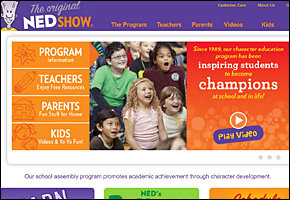 The Ned Program school-wide character education program centers around a 45 minute assembly called The NED Show. NED is a loveable cartoon character whose name is an acronym for Never give up, Encourage others, and Do your best. Teachers love that NED is simple, relatable and kid-focused.
The Ned Program school-wide character education program centers around a 45 minute assembly called The NED Show. NED is a loveable cartoon character whose name is an acronym for Never give up, Encourage others, and Do your best. Teachers love that NED is simple, relatable and kid-focused.
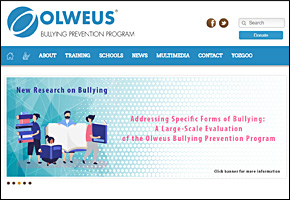 The Olweus Bullying Prevention Program is designed to improve peer relations and make schools safer, more positive places for students to learn and develop.
The Olweus Bullying Prevention Program is designed to improve peer relations and make schools safer, more positive places for students to learn and develop.
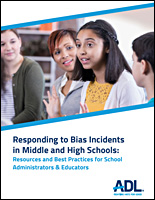 Anti-Defamation League – This toolkit is a resource to help educators and school administrators strengthen their responses to school-based incidents of bias and bigotry.
Anti-Defamation League – This toolkit is a resource to help educators and school administrators strengthen their responses to school-based incidents of bias and bigotry.
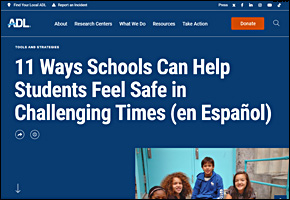 Anti-Defamation League – In this article, find prevention, intervention and education strategies in order to promote inclusive school environments where young people can learn, thrive and become their best selves.
Anti-Defamation League – In this article, find prevention, intervention and education strategies in order to promote inclusive school environments where young people can learn, thrive and become their best selves.
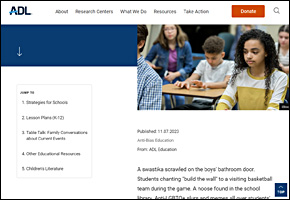 Anti-Defamation League – The most effective responses to bias-motivated incidents incorporate prevention, intervention and sustained anti-bias education. Use ADL’s teaching tools, lesson plans, discussion guides and other resources to help with your short and long-term incident response.
Anti-Defamation League – The most effective responses to bias-motivated incidents incorporate prevention, intervention and sustained anti-bias education. Use ADL’s teaching tools, lesson plans, discussion guides and other resources to help with your short and long-term incident response.
University of Connecticut NEAG School of Education – In this brief, policies and recent initiatives aimed at eliminating racism in schools are described and highlighted. As school and district leaders advance their own anti-racist policies and objectives, this policy brief provides guidance based on the practices of diverse districts in the U.S. and elsewhere.
Learn more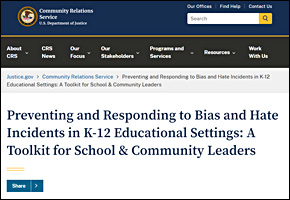 U.S. Department of Justice – Everyone deserves safe and inclusive learning environments free of harassment and discrimination. Well-designed and facilitated opportunities for groups to dialogue can enable communities to address differences, through respectful sharing of perspectives that move toward solutions focused on the common good.
U.S. Department of Justice – Everyone deserves safe and inclusive learning environments free of harassment and discrimination. Well-designed and facilitated opportunities for groups to dialogue can enable communities to address differences, through respectful sharing of perspectives that move toward solutions focused on the common good.
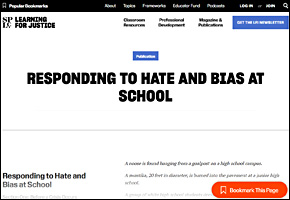 Learning for Justice – Bias incidents are far too complex for on-the-fly planning; an early misstep can heighten tension and damage chances for long-term success. Responding to Hate and Bias at School is designed primarily for school administrators, but teachers, staff, counselors, students and others also may find guidance here.
Learning for Justice – Bias incidents are far too complex for on-the-fly planning; an early misstep can heighten tension and damage chances for long-term success. Responding to Hate and Bias at School is designed primarily for school administrators, but teachers, staff, counselors, students and others also may find guidance here.
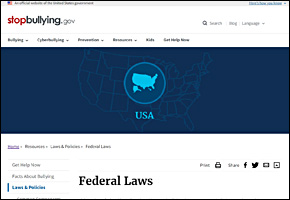 StopBullying.gov – Although no federal law directly addresses bullying, in some cases, bullying overlaps with discriminatory harassment when it is based on race, national origin, color, sex (including sexual orientation and gender identity), age, disability, or religion. Federally-funded schools (including colleges and universities) have an obligation to resolve harassment on these bases.
StopBullying.gov – Although no federal law directly addresses bullying, in some cases, bullying overlaps with discriminatory harassment when it is based on race, national origin, color, sex (including sexual orientation and gender identity), age, disability, or religion. Federally-funded schools (including colleges and universities) have an obligation to resolve harassment on these bases.
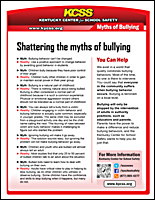 Topics on this handout include: “Shattering the myths of bullying”, “You Can Help”, “Who’s the bully… not my child!” and “Why don’t kids ask for help?” (KCSS 2-Sided Handout)
Topics on this handout include: “Shattering the myths of bullying”, “You Can Help”, “Who’s the bully… not my child!” and “Why don’t kids ask for help?” (KCSS 2-Sided Handout)
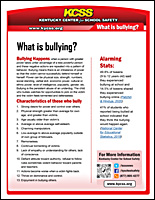 Topics on this handout include: “Characteristics of those who bully”, “Alarming Stats” and “Who are the victims?” (KCSS 2-Sided Handout)
Topics on this handout include: “Characteristics of those who bully”, “Alarming Stats” and “Who are the victims?” (KCSS 2-Sided Handout)
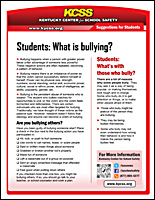 Topics on this handout include: “What is Bullying?”, “Are you bullying others?”, “Students: What’s with those who bully?”, “Bystanders to Bullying” and “Why don’t kids ask for help?” (KCSS 2-Sided Handout)
Topics on this handout include: “What is Bullying?”, “Are you bullying others?”, “Students: What’s with those who bully?”, “Bystanders to Bullying” and “Why don’t kids ask for help?” (KCSS 2-Sided Handout)
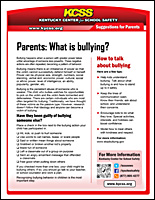 Topics on this handout include: “What is Bullying?”, “Have they been guilty of bullying someone else?”, “Parents: How to talk about bullying”, “What’s up with all the bullying behavior?”, “5 Tips for parents to prevent bullying” and “Safe on Social Media!” (KCSS 2-Sided Handout)
Topics on this handout include: “What is Bullying?”, “Have they been guilty of bullying someone else?”, “Parents: How to talk about bullying”, “What’s up with all the bullying behavior?”, “5 Tips for parents to prevent bullying” and “Safe on Social Media!” (KCSS 2-Sided Handout)
 Educate the school staff and students on the real definition of bullying. Be consistent when enforcing policies and codes of conduct (after these have been revised and work for your school). (KCSS Handout)
Educate the school staff and students on the real definition of bullying. Be consistent when enforcing policies and codes of conduct (after these have been revised and work for your school). (KCSS Handout)
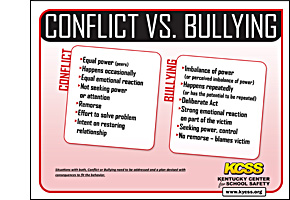 When talking with your students use these handouts. Everyone needs to know the difference between conflict and bullying. Review these in classrooms and place them on the wall to refer to every now and then. (KCSS Handout)
When talking with your students use these handouts. Everyone needs to know the difference between conflict and bullying. Review these in classrooms and place them on the wall to refer to every now and then. (KCSS Handout)
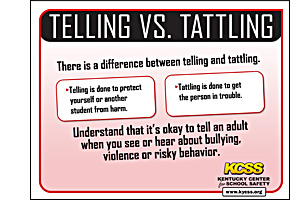 When talking with your students use this handout. Everyone needs to know the difference between telling and tattling. Review these in classrooms and place them on the wall to refer to every now and then. (KCSS Handout)
When talking with your students use this handout. Everyone needs to know the difference between telling and tattling. Review these in classrooms and place them on the wall to refer to every now and then. (KCSS Handout)
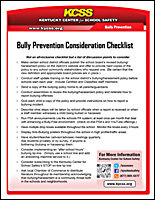 Jon Akers, Executive Director of KCSS, offers suggestions for principals to consider when establishing bullying/harassment standards within their respective schools. This is not an all-inclusive list…but it is a good start for principals to reflect and act accordingly. (KCSS Handout)
Jon Akers, Executive Director of KCSS, offers suggestions for principals to consider when establishing bullying/harassment standards within their respective schools. This is not an all-inclusive list…but it is a good start for principals to reflect and act accordingly. (KCSS Handout)
 If someone threatens a school or school activity in any way that causes the school to have to evacuate (to keep students and teachers safe), that is called terroristic threatening. (KCSS Handout)
If someone threatens a school or school activity in any way that causes the school to have to evacuate (to keep students and teachers safe), that is called terroristic threatening. (KCSS Handout)
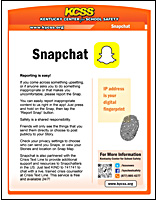 This handout addresses online “Threats at School.” Many students are not aware of the fact that all social media acquire and log “IP addresses” even Snapchat. This is a handout to help you explain how law enforcement can obtain anyone’s personal information from any of these apps. Then law enforcement can find the offending student and press charges. The student who creates, reposts or sends the fear-provoking material will suffer the consequences of this felony. (KCSS Handout)
This handout addresses online “Threats at School.” Many students are not aware of the fact that all social media acquire and log “IP addresses” even Snapchat. This is a handout to help you explain how law enforcement can obtain anyone’s personal information from any of these apps. Then law enforcement can find the offending student and press charges. The student who creates, reposts or sends the fear-provoking material will suffer the consequences of this felony. (KCSS Handout)
 Bookmarks are fun and they are a great way to encourage students with a theme. This Seuss inspired bookmark is for early elementary and rhymes. It promotes kindness and sharing. Everyday, let’s enjoy reading and show kindness, helping make our schools a great place to learn and grow.
Bookmarks are fun and they are a great way to encourage students with a theme. This Seuss inspired bookmark is for early elementary and rhymes. It promotes kindness and sharing. Everyday, let’s enjoy reading and show kindness, helping make our schools a great place to learn and grow.
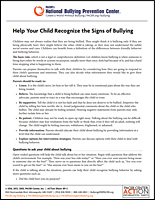 Parents can prepare themselves to talk with their children by considering how they are going to handle their child’s questions and emotions. They can also decide what information they would like to give their child about bullying. (From PACER)
Parents can prepare themselves to talk with their children by considering how they are going to handle their child’s questions and emotions. They can also decide what information they would like to give their child about bullying. (From PACER)
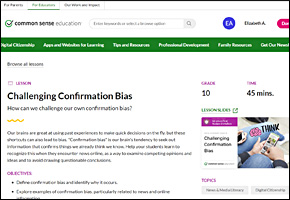 Common Sense Education – Our brains are great at using past experiences to make quick decisions on the fly, but these shortcuts can also lead to bias. “Confirmation bias” is our brain’s tendency to seek out information that confirms things we already think we know. Help your students learn to recognize this when they encounter news online, as a way to examine competing opinions and ideas and to avoid drawing questionable conclusions.
Common Sense Education – Our brains are great at using past experiences to make quick decisions on the fly, but these shortcuts can also lead to bias. “Confirmation bias” is our brain’s tendency to seek out information that confirms things we already think we know. Help your students learn to recognize this when they encounter news online, as a way to examine competing opinions and ideas and to avoid drawing questionable conclusions.
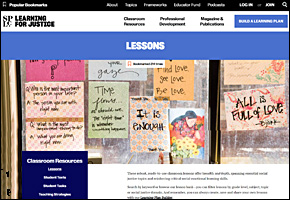 Teaching Tolerance – These robust, ready-to-use classroom lessons offer breadth and depth, spanning essential social justice topics and reinforcing critical social emotional learning skills.
Teaching Tolerance – These robust, ready-to-use classroom lessons offer breadth and depth, spanning essential social justice topics and reinforcing critical social emotional learning skills.
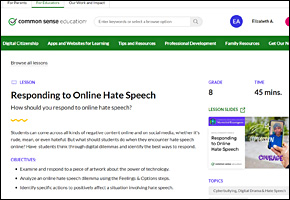 Common Sense Education – As humans, we thrive on social connections and group associations. But this tendency can also lead us to be suspicious of people outside our group. This fear — xenophobia — can be overcome by more exposure to people who are different from us. However, the internet can often make this more difficult. Help students recognize this challenge and find strategies for navigating content online.
Common Sense Education – As humans, we thrive on social connections and group associations. But this tendency can also lead us to be suspicious of people outside our group. This fear — xenophobia — can be overcome by more exposure to people who are different from us. However, the internet can often make this more difficult. Help students recognize this challenge and find strategies for navigating content online.
Common Sense Education – Students can come across all kinds of negative content online and on social media, whether it’s rude, mean, or even hateful. But what should students do when they encounter hate speech online? Have students think through digital dilemmas and identify the best ways to respond.
Learn more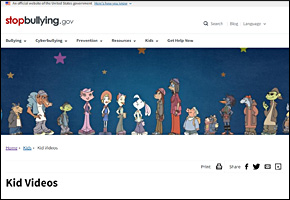 Learn about bullying by watching videos, reading along, and taking quizzes. Videos for younger kids are available to learn what bullying is, and read along, too! Videos for older kids are available. Learn how KB, Josh, Milton, and their friends deal with bullying. After watching videos, a bullying quiz can be taken. (stopbullying.gov)
Learn about bullying by watching videos, reading along, and taking quizzes. Videos for younger kids are available to learn what bullying is, and read along, too! Videos for older kids are available. Learn how KB, Josh, Milton, and their friends deal with bullying. After watching videos, a bullying quiz can be taken. (stopbullying.gov)
 A collection of videos, along with a few sent in by audiences. All are curated around content themes of bullying prevention, kindness, acceptance and inclusion. (PACER’S National Center for Bully Prevention)
A collection of videos, along with a few sent in by audiences. All are curated around content themes of bullying prevention, kindness, acceptance and inclusion. (PACER’S National Center for Bully Prevention)
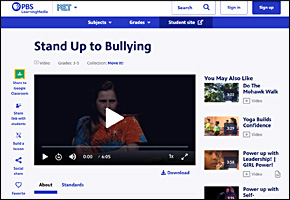 This video depicts a mock bullying scene with children playing a game and excluding one child. During the mock segment, Mackenzie, the host, identifies what bullying is, the different forms of bullying, and what to do if you or a friend is being bullied. Finally, the scene is replayed with a different outcome with all three children engaging with each other. (PBS Learning Media)
This video depicts a mock bullying scene with children playing a game and excluding one child. During the mock segment, Mackenzie, the host, identifies what bullying is, the different forms of bullying, and what to do if you or a friend is being bullied. Finally, the scene is replayed with a different outcome with all three children engaging with each other. (PBS Learning Media)
 The Foundation for a Better Life creates public service campaigns to communicate positive values. “Locker” – In this motivational commercial a boy is accosted by bullies at school, but pleasantly surprised when he is helped by another student. This models a positive example of reaching out to someone else in need. “Cafeteria” – Girls are sometimes more verbally aggressive and this commercial shows how a new student is mistreated, just because she is new. On a positive note, she is rescued by a student doing the right thing by making a choice to treat her with respect.
The Foundation for a Better Life creates public service campaigns to communicate positive values. “Locker” – In this motivational commercial a boy is accosted by bullies at school, but pleasantly surprised when he is helped by another student. This models a positive example of reaching out to someone else in need. “Cafeteria” – Girls are sometimes more verbally aggressive and this commercial shows how a new student is mistreated, just because she is new. On a positive note, she is rescued by a student doing the right thing by making a choice to treat her with respect.
Kentucky Department of Education – The Division of Diversity, Equity, Inclusion and Belonging offers a menu of professional learning opportunities.
Learn moreKentucky Department of Education – The Kentucky Department of Education (KDE) Team of Diversity, Equity, Inclusion and Belonging (DEIB), which is a part of the Office of Teaching and Learning, is committed to fostering an inclusive learning environment in which all Kentucky public school students receive equitable access and opportunities.
Learn more Kentucky Department of Education – This guidance was prepared by the Kentucky Department of Education’s (KDE’s) cross-agency Trauma and Resilience Team, in partnership with colleagues from the Kentucky Department for Behavioral Health, Developmental and Intellectual Disabilities and KDE’s Diversity, Equity, Inclusion and Belonging Team.
Kentucky Department of Education – This guidance was prepared by the Kentucky Department of Education’s (KDE’s) cross-agency Trauma and Resilience Team, in partnership with colleagues from the Kentucky Department for Behavioral Health, Developmental and Intellectual Disabilities and KDE’s Diversity, Equity, Inclusion and Belonging Team.
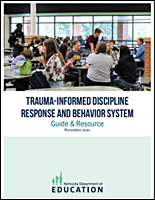 Kentucky Department of Education – Student behavior that is challenging may be related to traumatic stress responses. To be effective at maintaining a safe and supportive learning environment for all students and staff, schools should utilize trauma-informed disciplinary policies and practices that avoid retraumatization, reduce potential escalation of difficult behavior and are embedded in a system of positive behavior supports.
Kentucky Department of Education – Student behavior that is challenging may be related to traumatic stress responses. To be effective at maintaining a safe and supportive learning environment for all students and staff, schools should utilize trauma-informed disciplinary policies and practices that avoid retraumatization, reduce potential escalation of difficult behavior and are embedded in a system of positive behavior supports.
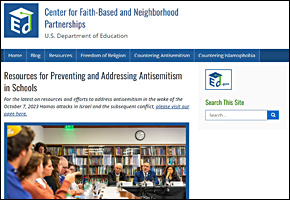 US Department of Education Center for Faith-Based and Neighborhood Partnerships – The following resources are aimed at helping students, educators, and communities ensure that all students, including Jewish students, have safe and supportive learning environments.
US Department of Education Center for Faith-Based and Neighborhood Partnerships – The following resources are aimed at helping students, educators, and communities ensure that all students, including Jewish students, have safe and supportive learning environments.
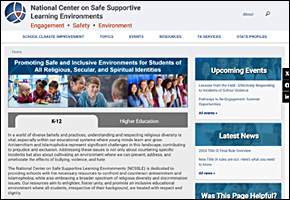 National Center on Safe Supportive Learning Environments – In coordination with the U.S. Department of Education’s Free to Learn initiative, NCSSLE has curated a collection of specialized resources designed for educators, students, parents, and community members. These tools equip users with knowledge and strategies to challenge discrimination, fostering spaces where every student feels valued and can thrive academically and socially. Let us work collectively to ensure safety, support, and mutual respect in our schools.
National Center on Safe Supportive Learning Environments – In coordination with the U.S. Department of Education’s Free to Learn initiative, NCSSLE has curated a collection of specialized resources designed for educators, students, parents, and community members. These tools equip users with knowledge and strategies to challenge discrimination, fostering spaces where every student feels valued and can thrive academically and socially. Let us work collectively to ensure safety, support, and mutual respect in our schools.
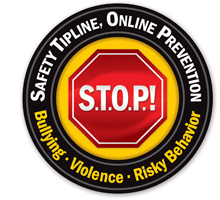 (Kentucky Office of Homeland Security) – Use this tip line (or call 1-866-393-6659) to report concerns of any kind, whether it be at home or at school. You may report anonymously, or choose to be contacted. This is a free service for all Kentuckians.
(Kentucky Office of Homeland Security) – Use this tip line (or call 1-866-393-6659) to report concerns of any kind, whether it be at home or at school. You may report anonymously, or choose to be contacted. This is a free service for all Kentuckians.
 Jon Akers, Executive Director of KCSS, offers suggestions for principals to consider when establishing bullying/harassment standards within their respective schools. This is not an all-inclusive list…but it is a good start for principals to reflect and act accordingly. (KCSS Handout)
Jon Akers, Executive Director of KCSS, offers suggestions for principals to consider when establishing bullying/harassment standards within their respective schools. This is not an all-inclusive list…but it is a good start for principals to reflect and act accordingly. (KCSS Handout)
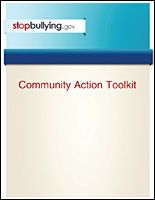 StopBullying.gov – Every phase of community assessment, planning and evaluation entails a process of shared decision-making and coordination in carrying out the tasks assigned. Conducting a landscape assessment of bullying prevention strategies that may already exist in your community will inform your own efforts and provide a better understanding of how receptive your community will be to a bullying prevention campaign.
StopBullying.gov – Every phase of community assessment, planning and evaluation entails a process of shared decision-making and coordination in carrying out the tasks assigned. Conducting a landscape assessment of bullying prevention strategies that may already exist in your community will inform your own efforts and provide a better understanding of how receptive your community will be to a bullying prevention campaign.
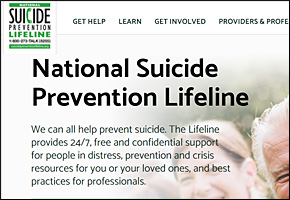 While bullying doesn’t cause suicide, a stressful environment and persistent, emotional victimization can increase a person’s risk of suicide. Together, we can create awareness about the dangers of bullying and give emotional support to those who may be contemplating suicide. If you or someone you know is in an emotional distress or suicidal crisis, please call the Lifeline at 1-800-273-TALK (8255). (National Suicide Prevention Lifeline)
While bullying doesn’t cause suicide, a stressful environment and persistent, emotional victimization can increase a person’s risk of suicide. Together, we can create awareness about the dangers of bullying and give emotional support to those who may be contemplating suicide. If you or someone you know is in an emotional distress or suicidal crisis, please call the Lifeline at 1-800-273-TALK (8255). (National Suicide Prevention Lifeline)
 How to talk to your kids about being online, and how to help them make good decisions and stay safe. Resources on topics include cyberbullying, online security, mobile devices, socializing online, video games, texting and sexting. (The Federal Trade Commission)
How to talk to your kids about being online, and how to help them make good decisions and stay safe. Resources on topics include cyberbullying, online security, mobile devices, socializing online, video games, texting and sexting. (The Federal Trade Commission)
 Here are a few survey samples
Here are a few survey samples
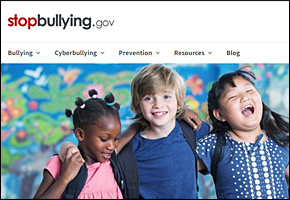 Assessments—such as surveys—can help schools determine the frequency and locations of bullying behavior. They can also gauge the effectiveness of current prevention and intervention efforts. Knowing what’s going on can help school staff select appropriate prevention and response strategies. Assessments involve asking school or community members—including students—about their experiences and thoughts related to bullying. An assessment is planned, purposeful, and uses research tools. (StopBullying.gov)
Assessments—such as surveys—can help schools determine the frequency and locations of bullying behavior. They can also gauge the effectiveness of current prevention and intervention efforts. Knowing what’s going on can help school staff select appropriate prevention and response strategies. Assessments involve asking school or community members—including students—about their experiences and thoughts related to bullying. An assessment is planned, purposeful, and uses research tools. (StopBullying.gov)
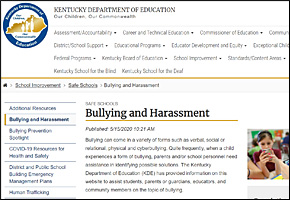 Kentucky Department of Education – Bullying can come in a variety of forms such as verbal, social or relational, physical and cyberbullying. Quite frequently, when a child experiences a form of bullying, parents and/or school personnel need assistance in identifying possible solutions.
Kentucky Department of Education – Bullying can come in a variety of forms such as verbal, social or relational, physical and cyberbullying. Quite frequently, when a child experiences a form of bullying, parents and/or school personnel need assistance in identifying possible solutions.
Regulations/Statutes
KRS 158.148 – Definition of “bullying” — discipline guidelines and model policy — local code of acceptable behavior and discipline — required contents of code
KRS 525.070 – Harassment
KRS 525.080 – Harassing Communications
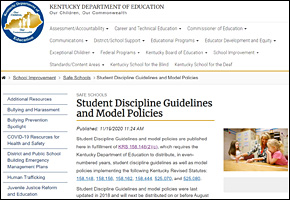 Kentucky Department of Education – Student Discipline Guidelines and model policies are published here in fulfillment of KRS 158.148(2)(c), which requires the Kentucky Department of Education to distribute, in even-numbered years, student discipline guidelines as well as model policies implementing the following Kentucky Revised Statutes: 158.148, 158.156, 158.162, 158.444, 525.070, and 525.080. (includes bullying, harassing, etc.)
Kentucky Department of Education – Student Discipline Guidelines and model policies are published here in fulfillment of KRS 158.148(2)(c), which requires the Kentucky Department of Education to distribute, in even-numbered years, student discipline guidelines as well as model policies implementing the following Kentucky Revised Statutes: 158.148, 158.156, 158.162, 158.444, 525.070, and 525.080. (includes bullying, harassing, etc.)
 Safe Supportive Learning – U.S. Department of Education – Kentucky laws and regulations are listed.
Safe Supportive Learning – U.S. Department of Education – Kentucky laws and regulations are listed.
LAWS
KRS 2.227. Anti-Bullying Month; KRS 158.156. Reporting of commission of felony KRS Chapter 508 offense against a student–Investigation–Immunity from liability for reporting–Privileges no bar to reporting; KRS 158.183. Prohibited acts by students–Rights of student–Duties of local board of education–Administrative remedies; KRS 525.070. Harassment; KRS 525.080. Harassing communications
Learn more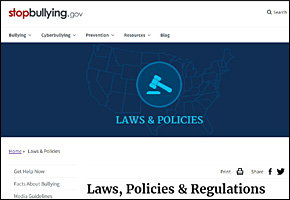 State and local lawmakers have taken action to prevent bullying and protect children. Through laws (in their state education codes and elsewhere) and model policies (that provide guidance to districts and schools), each state addresses bullying differently. Each state refers to bullying in its laws and what they require on part of schools and districts. By clicking the link above you can access a map with each state’s information. (StopBullying.gov)
State and local lawmakers have taken action to prevent bullying and protect children. Through laws (in their state education codes and elsewhere) and model policies (that provide guidance to districts and schools), each state addresses bullying differently. Each state refers to bullying in its laws and what they require on part of schools and districts. By clicking the link above you can access a map with each state’s information. (StopBullying.gov)
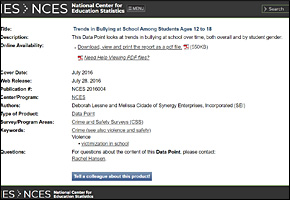 Reports from the National Center for Education Statistics, in the Institute of Education Sciences, use data collected in the School Crime Supplement to the National Crime Victimization Survey. Three Data Points released July 28, 2016 look at trends in reports of bullying, use of hate-related words, etc. in the nation’s schools. (1) Trends in Bullying at School Among Students Ages 12 to 18 (2) Trends in Hate-Related Words at School Among Students Ages 12 to 18 (3) Reports of Bullying and Other Unfavorable Conditions at School
Reports from the National Center for Education Statistics, in the Institute of Education Sciences, use data collected in the School Crime Supplement to the National Crime Victimization Survey. Three Data Points released July 28, 2016 look at trends in reports of bullying, use of hate-related words, etc. in the nation’s schools. (1) Trends in Bullying at School Among Students Ages 12 to 18 (2) Trends in Hate-Related Words at School Among Students Ages 12 to 18 (3) Reports of Bullying and Other Unfavorable Conditions at School
Three Data Points released March 15, 2018 look at trends in reports of bullying, repetition and power imbalance as components of the uniform definition of bullying, and the relationship between students’ feelings of safety in school … (1) Changes in Bullying Victimization and Hate-Related Words at School Since 2007 (2) Students’ Relationships in School and Feelings about Personal Safety at School (3) Repetition and Power Imbalance in Bullying Victimization at School